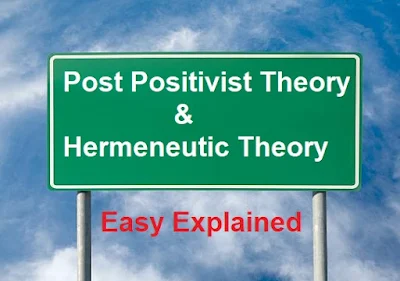Theories are stories about how and why events
occur. “A theory consists of a set of interrelated propositions that stipulate
relationships among theoretical constructs and an account of the mechanism or
mechanisms that explain the relationships stipulated in the propositions”.
Kenneth Bailey’s conception of theory accepts a wider array of ways to
understand the social world: “Explanations and predictions of social phenomena
… relating the subject of interest… to some other phenomena”
Post Positivist Theory
When communication researchers first wanted to
systematically study the social world, they turned to the physical sciences for
their model. Those in the physical sciences (physics, chemistry, astronomy, and
so on) believed in positivism, the idea that knowledge could be gained only
through empirical, observable, measurable phenomena examined through the
scientific method. But as we saw earlier in this chapter, people are not
beakers of water. As a result, social scientists committed to the scientific
method practice Post Positivist theory. This theory is based on empirical
observation guided by the scientific method, but it recognizes that humans and
human behavior are not as constant as elements of the physical world.
The goals of Post Positivist theory are
explanation, prediction, and control (and in this you can see the connection
between this kind of social science and the physical sciences). For example,
researchers who want to explain the operation of political advertising, predict
which commercials will be most effective, and control the voting behavior of
targeted citizens would, of necessity, rely on Post Positivist theory. Its
ontology accepts that the world, even the social world, exists apart from our
perceptions of it; human behavior is sufficiently predictable to be studied systematically.
(Post Positivists do, however, believe that the social world does have more
variation than the physical world; for example, the names we give to things
define them and our reaction to them—hence the post of postpositivism).
Its epistemology argues that knowledge is
advanced through the systematic, logical search for regularities and causal
relationships employing the scientific method. Advances come when there is
intersubjective agreement among scientists studying a given phenomenon. That
is, Post Positivists find confidence “in the community of social researchers,”
not “in any individual social scientist”. It is this cautious reliance on the
scientific method that defines postpositivism’s axiology— the objectivity
inherent in the application of the scientific method keeps researchers’ and
theorists’ values out of the search for knowledge (as much as is possible).
Post[1]positivist
communication theory, then, is theory developed through a system of inquiry
that resembles as much as possible the rules and practices of what we
traditionally understand as science.
Hermeneutic Theory
Many communication theorists do not want to explain,
predict, and control social behavior. Their goal is to understand how and why
that behavior occurs in the social world. This hermeneutic theory is the study
of understanding, especially through the systematic interpretation of actions
or texts. Hermeneutics originally began as the study or interpretation of the
Bible and other sacred works. As it evolved over the last two centuries, it
maintained its commitment to the examination of “objectifications of the mind”,
or what Miller calls “social creations”. Just as the Bible was the “objectification”
of early Christian culture, and those who wanted to understand that culture
would study that text, most modern applications of hermeneutics are likewise
focused on understanding the culture of the users of a specific text.
There are different forms of hermeneutic theory.
For example, social hermeneutics has as its goal the understanding of how those
in an observed social situation interpret their own lot in that situation. As
ethnographer Michael Moerman explained, social hermeneutic theory tries to
understand how events “in the alien world make sense to the aliens, how their
way of life coheres and has meaning and value for the people who live it”.
Another branch of hermeneutics looks for hidden or deep meaning in people’s
interpretation of different symbol systems—for example, in media texts. As you
might have guessed from these descriptions, hermeneutic theory is sometimes
referred to as interpretive theory. Another important idea embedded in these
descriptions is that any text, any product of social interaction—a movie, the
president’s State of the Union Address, a series of Twitter tweets, a
conversation between a soap opera hero and heroine— can be a source of
understanding.
The ontology of hermeneutic theory says that there
is no truly “real,” measurable social reality. Instead, “people construct an
image of reality based on their own preferences and prejudices and their
interactions with others, and this is as true of scientists as it is of
everyone else in the social world”. As such, hermeneutic theory’s epistemology,
how knowledge is advanced, relies on the subjective interaction between the
observer (the researcher or theorist) and his or her community. Put another
way, knowledge is local; that is, it is specific to the interaction of the
knower and the known. Naturally, then, the axiology of hermeneutic theory
embraces, rather than limits, the influence of researcher and theorist values.
Personal and professional values, according to Katherine Miller, are a “lens through
which social phenomena are observed”. A researcher interested in understanding
teens’ interpretations of social networking websites like Facebook, or one who
is curious about meaning-making that occurs in the exchange of information
among teen fans of an online simulation game, would rely on hermeneutic theory.
Diffusion of Innovation Theory
Keywords: Post Positivist
Theory, Positivism, Hermeneutic Theory, Difference between a post positivistic
and a hermeneutic research paradigm, Communication Theory, Theories of
Communication, Mass Communication



